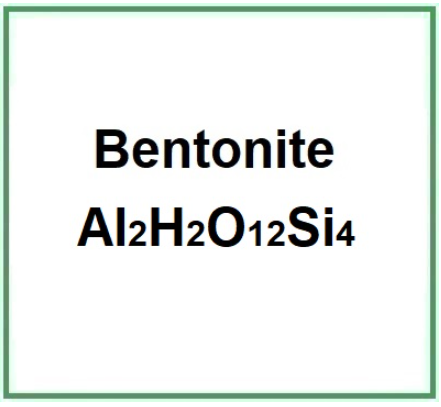E558 (Bentonite) is a type of phyllosilicate aluminium-absorbing natural clay, a volcanic material that dates back millions of years and is now a mineral mined and used as a powder mainly in the USA at Fort Benton (Wyoming) where it was discovered in 1848. There are various types of bentonite in the world with different degrees of size, purity, swelling, adsorption. It is mainly composed of montmorillonite (belonging to the 2:1 type clays), feldspar, calcite and quartz and has the ability to form thixotropic gels with water.
It is also known as Montmorillonite, Fuller's earth, Solum fullonum.
It is in the form of a whitish, highly absorbent powder (it swells 20 times in contact with water).

What it is used for and where
The most commercially used form is sodium bentonite (CAS 85049-30-5) for its swelling properties as a retarding gel and emulsion stabiliser by the oil industry in well drilling.
Calcium bentonite (CAS 97862-66-3) is used by the foundry, mould-making, industrial oil and edible oil refining industries.
Medical and Pharmaceutical
It is an FDA-cleared food additive used in the preparation of various bionanocomposites, a detoxifying agent and inhibitor of the growth of certain cancer cells (1). The scientific literature agrees on the absence of any negative effect of Bentonite on human health.
In pharmaceuticals, Bentonite, in gel form, is used as a carrier for transporting drugs
Food
Ingredient listed in the European Food Additives List as E558 as anti-caking agent and in the Colour Index International as CI 77004, colouring agent.
Decolouring agent for spirits, vinegar, beer. In the winemaking process, it removes, particularly from white wines, excess proteins that can cause turbidity in the wine, a rather common effect that does not affect the quality of the wine, but is disliked by most consumers. To achieve the same result, grape seed powder can be added instead of bentonite to obtain a wine without turbidity (2).
Safety
It should be considered that the risk of cumulative intake of aluminium, which can pose a danger to human health, cannot be excluded as this ingredient can be found in widely consumed food products (3).
Pets
Odour absorber and sanitiser in pet bedding.
Cosmetics
Absorbent. Absorbs substances dispersed or dissolved in aqueous solutions, water/oil, oil/water.
Anticaking agent. This chemical compound facilitates free flow and prevents aggregation or clumping of substances in a formulation by reducing the tendency of certain particles to stick together.
Bulking agent. It regulates the water content, dilutes other solids, can increase the volume of a product for better flow, acts as a buffer against organic acids, helps to keep the pH of the mixture within a certain level.
Gel former. It acts as a viscosity enhancer to increase gel stability and is evenly distributed on a molecular scale as it can be engineered by the chemist at the molecular level. Definitely recommended in depilatories, foam baths.
Opacifying agent. This additive is inserted into formulations that may be translucent or transparent to make them opaque and less permeable to light.
Viscosity control agent. It controls and adapts viscosity to the required level for optimal chemical and physical stability of the product and dosage in gels, suspensions, emulsions, solutions.
Bentonite with lecithin in a water-oil emulsion has proved useful in protecting the skin from urban aerosols and cedar pollen (4).
Other uses
Sealant for ponds or artificial lakes. Anti-caking agent for animal feed. Binder for the formation of iron ore pellets. Binder for the production of moulds in foundries. Lubricant and coolant for cutting tools. Improves water treatment process for removal of cyanobacteria, cyanotoxins and other pollutants.
For more information:
Bentonite studies
| Appearance | Powder |
| pH | 9 |
Boiling Point
| 381.8±37.0°C at 760 mmHg |
Flash Point
| 184.7±26.5°C |
| Density | 1.5±0.1 g/cm3 |
| PSA | 189.16000 |
| LogP | 2.24 |
Vapor Pressure
| 0.0±0.9 mmHg at 25°C |
| Refraction Index | 1.503 |
Loss on ignition
| 34.5~37.5% |
Viscosity
| ≥1.5 Pa•s |
Fineness≤ 76um (200 mesh)
| ≥95% |
Bentonite, sodian
- Molecular Formula Al2H2O12Si4
- Molecular Weight 284.181
- Exact Mass 284.060425
- CAS 1302-78-9
- UNII A3N5ZCN45C
- EC Number 215-108-5
- DSSTox Substance ID
- IUPAC
- InChI=1S/2Al.O2Si.H2O.3O/c;;1-3-2;;;;/h;;;1H2;;;
- InChl Key SVPXDRXYRYOSEX-UHFFFAOYSA-N
- SMILES O.O=[Al]O[Al]=O.O=[Si]=O
- MDL number MFCD00130611
- PubChem Substance ID 24856869
- RTECS CT9450000
Synonyms
- Bengel
- Albagel
- Bentonit
- nitrilotriethane-2,1-diyl trinitrate
- trolnitrate
- Montmorillinite clay
- Clarit
- Culvin
- Detercal
- Detercol
References_________________________________________________________________________
(1) Cervini-Silva J, Ramírez-Apan MT, Kaufhold S, Ufer K, Palacios E, Montoya A. Role of bentonite clays on cell growth. Chemosphere. 2016 Apr;149:57-61. doi: 10.1016/j.chemosphere.2016.01.077.
(2) Romanini E, McRae JM, Colangelo D, Lambri M. First trials to assess the feasibility of grape seed powder (GSP) as a novel and sustainable bentonite alternative. Food Chem. 2020 Feb 1;305:125484. doi: 10.1016/j.foodchem.2019.125484.
(3) Wong, W.W., Chung, S.W., Kwong, K.P., Yin Ho, Y. and Xiao, Y., 2010. Dietary exposure to aluminium of the Hong Kong population. Food Additives and Contaminants, 27(4), pp.457-463.
Bratakos, S.M., Lazou, A.E., Bratakos, M.S. and Lazos, E.S., 2012. Aluminium in food and daily dietary intake estimate in Greece. Food Additives and Contaminants: Part B, 5(1), pp.33-44.
(4) Iwanaga T, Nioh A, Reed N, Kiyokawa H, Akatsuka H. A novel water-in-oil emulsion with a lecithin-modified bentonite prevents skin damage from urban dust and cedar pollen. Int J Cosmet Sci. 2020 Jun;42(3):229-236. doi: 10.1111/ics.12605.
![]() E558
E558 





